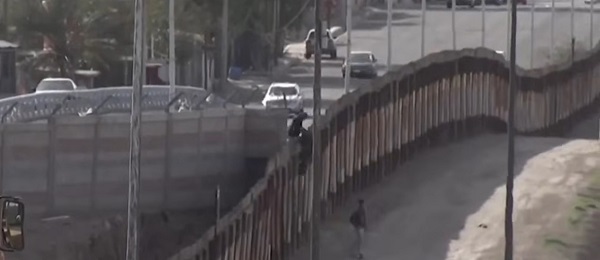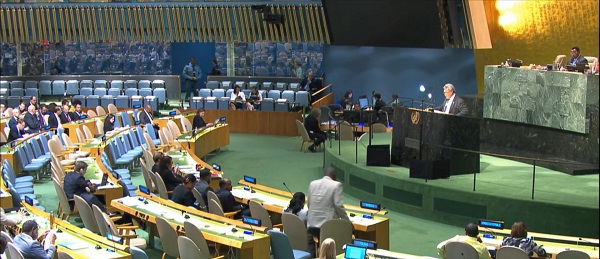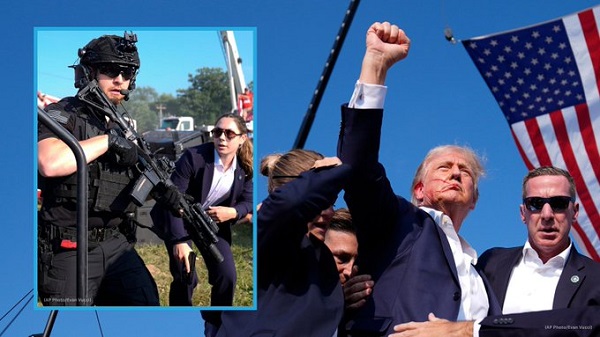Daily Caller
Smugglers Reportedly Telling Migrants To Hoof It Toward Border Before Trump Takes Office

 From the Daily Caller News Foundation
From the Daily Caller News Foundation
Human smugglers are reportedly urging migrants to rush into the United States before President-elect Donald Trump comes back into power, according to the Wall Street Journal
Migrants across Latin America are being told by smugglers that the time is now to reach the U.S. southern border before Trump enters office and embarks on his hardline immigration agenda, according to a report by the WSJ. Officials on the U.S. side of the southern border told the Daily Caller News Foundation that they are bracing for the possibility of a last-minute migrant surge before inauguration day.
“I am deeply concerned about the potential for a surge at our southern border as we near the end of President Biden’s term,” San Diego County Supervisor Jim Desmond, who represents a district by the California-Mexico border, stated to the DCNF. “With the Trump Administration signaling that it will prioritize stricter immigration enforcement, many individuals seeking to enter the U.S. illegally are likely to try to do so before those policies are enacted.”
“Right now, we are already seeing 800 to 1,000 people entering our region daily, creating a massive strain on our resources, services, and communities,” Desmond continued. “The influx is overwhelming local infrastructure and endangering the well-being of residents.”
Close to the Darien Gap — a vast jungle region spread across the Panama and Colombia border where thousands of U.S-bound migrants cross every year — migrants were told by a smuggler that he anticipates more deportations under the Trump administration, according to a WhatsApp group message reviewed by the WSJ.
“There were four WhatsApp groups in which hundreds of migrants coordinated their departure on U.S. election day,” Luis Villagrán, a Mexican migrant advocate who helps organize caravans in Tapachula, told the WSJ.
“As soon as Trump’s victory became clear, messages spreading fear began to appear,” Villagrán said.
In a statement to the DCNF, a Customs and Border Protection (CBP) spokesperson said the agency is remaining vigilant to ever-changing migration patterns, and urged migrants to “not believe the lies” of smugglers.
“The fact remains: the United States continues to enforce immigration law. Individuals who enter the U.S. unlawfully between ports of entry will continue to be quickly removed,” the CBP spokesperson said.
Upon entering office, President Joe Biden undertook 296 executive actions on immigration, with 89 of those orders specifically reversing or beginning the process of reversing Trump’s immigration policies. The Biden-Harris administration went on to undo a number of major Trump-era initiatives concerning border security, such as ending border wall construction and shutting down the Remain in Mexico program.
The aftermath was a historic flow of illegal immigration across the southern border. The number of illegal border crossings in fiscal year 2024 were the second worst in U.S. history — only surpassed by fiscal year 2023, according to data tracked by CBP.
There were about 8.5 million migrant encounters along the U.S.-Mexico border during the four fiscal years of the Biden-Harris administration.
Trump, who is set to return to office in January, was very clear about his immigration enforcement platform while on the campaign trail.
The president-elect has pledged to continue building the U.S.-Mexico border wall, revive the Remain in Mexico program, hire more border patrol agents and embark on the “largest deportation program in American history.” He has also pledged to put an end to birthright citizenship for those born on U.S. soil by illegal migrant parents.
The incoming administration appears poised to follow through this hardline agenda given the picks so far to lead top immigration enforcement roles. The White House transition team has tapped former Immigration and Customs Enforcement acting director Tom Homan to serve as border czar, Stephen Miller to serve as deputy chief of staff for policy and South Dakota Gov. Kristi Noem to lead the Department of Homeland Security.
Human smugglers and migrants south of the border appear to be paying attention to the American political scene. At least some migrants are now reportedly ditching the idea of booking an asylum appointment with U.S. officials and joining northbound caravans to the border.
“More than 20 friends decided not to wait for an appointment and joined the caravan,” Alfonso Meléndez, a 24-year-old Venezuelan national who arrived in southern Mexico in late September, stated to the WSJ.
“I’m very worried that they will throw us out when Trump takes office,” he continued.
Business
UN’s ‘Plastics Treaty’ Sports A Junk Science Wrapper


From the Daily Caller News Foundation
By Craig Rucker
According to a study in Science Advances, over 90% of ocean plastic comes from just 10 rivers, eight of which are in Asia. The United States, by contrast, contributes less than 1%. Yet Pew treats all nations as equally responsible, promoting one-size-fits-all policies that fail to address the real source of the issue.
Just as people were beginning to breathe a sigh of relief thanks to the Trump administration’s rollback of onerous climate policies, the United Nations is set to finalize a legally binding Global Plastics Treaty by the end of the year that will impose new regulations, and, ultimately higher costs, on one of the world’s most widely used products.
Plastics – derived from petroleum – are found in everything from water bottles, tea bags, and food packaging to syringes, IV tubes, prosthetics, and underground water pipes. In justifying the goal of its treaty to regulate “the entire life cycle of plastic – from upstream production to downstream waste,” the U.N. has put a bull’s eye on plastic waste. “An estimated 18 to 20 percent of global plastic waste ends up in the ocean,” the UN says.
As delegates from over 170 countries prepare for the final round of negotiations in Geneva next month, debate is intensifying over the future of plastic production, regulation, and innovation. With proposals ranging from sweeping bans on single-use plastics to caps on virgin plastic output, policymakers are increasingly citing the 2020 Pew Charitable Trusts report, Breaking the Plastic Wave, as one of the primary justifications.
But many of the dire warnings made in this report, if scrutinized, ring as hollow as an empty PET soda bottle. Indeed, a closer look reveals Pew’s report is less a roadmap to progress than a glossy piece of junk science propaganda—built on false assumptions and misguided solutions.
Pew’s core claim is dire: without urgent global action, plastic entering the oceans will triple by 2040. But this alarmist forecast glosses over a fundamental fact—plastic pollution is not a global problem in equal measure. According to a study in Science Advances, over 90% of ocean plastic comes from just 10 rivers, eight of which are in Asia. The United States, by contrast, contributes less than 1%. Yet Pew treats all nations as equally responsible, promoting one-size-fits-all policies that fail to address the real source of the issue.
This blind spot has serious consequences. Pew’s solutions—cutting plastic production, phasing out single-use items, and implementing rigid global regulations—miss the mark entirely. Banning straws in the U.S. or taxing packaging in Europe won’t stop waste from being dumped into rivers in countries with little or no waste infrastructure. Policies targeting Western consumption don’t solve the problem—they simply shift it or, worse, stifle useful innovation.
The real tragedy isn’t plastic itself, but the mismanagement of plastic waste—and the regulatory stranglehold that blocks better solutions. In many countries, recycling is a government-run monopoly with little incentive to innovate. Meanwhile, private-sector entrepreneurs working on advanced recycling, biodegradable materials, and AI-powered sorting systems face burdensome red tape and market distortion.
Pew pays lip service to innovation but ultimately favors centralized planning and control. That’s a mistake. Time and again, it’s been technology—not top-down mandates—that has delivered environmental breakthroughs.
What the world needs is not another top-down, bureaucratic report like Pew’s, but an open dialogue among experts, entrepreneurs, and the public where new ideas can flourish. Imagine small-scale pyrolysis units that convert waste into fuel in remote villages, or decentralized recycling centers that empower informal waste collectors. These ideas are already in development—but they’re being sidelined by policymakers fixated on bans and quotas.
Worse still, efforts to demonize plastic often ignore its benefits. Plastic is lightweight, durable, and often more environmentally efficient than alternatives like glass or aluminum. The problem isn’t the material—it’s how it has been managed after its use. That’s a “systems” failure, not a material flaw.
Breaking the Plastic Wave champions a top-down, bureaucratic vision that limits choice, discourages private innovation, and rewards entrenched interests under the guise of environmentalism. Many of the groups calling for bans are also lobbying for subsidies and regulatory frameworks that benefit their own agendas—while pushing out disruptive newcomers.
With the UN expected to finalize the treaty by early 2026, nations will have to face the question of ratification. Even if the Trump White House refuses to sign the treaty – which is likely – ordinary Americans could still feel the sting of this ill-advised scheme. Manufacturers of life-saving plastic medical devices, for example, are part of a network of global suppliers. Companies located in countries that ratify the treaty will have no choice but to pass the higher costs along, and Americans will not be spared.
Ultimately, the marketplace of ideas—not the offices of policy NGOs—will deliver the solutions we need. It’s time to break the wave of junk science—not ride it.
Craig Rucker is president of the Committee For A Constructive Tomorrow (www.CFACT.org).
Business
‘Experts’ Warned Free Markets Would Ruin Argentina — Looks Like They Were Dead Wrong


From the Daily Caller News Foundation
The current state of Argentina’s economy is a far cry from what “experts” predicted when they warned that President Javier Milei’s pro-free market leadership would devastate the country.
The chainsaw-wielding libertarian rose to power on promises to slash government spending, implement free-market policies and lift strict currency controls to rescue a nation crippled by inflation, debt and entrenched poverty. Though the pundit class warned that Milei’s policies would spark an economic collapse, the results so far have been a rebuke to those warnings.
Just days before the November 2023 presidential election, 108 economists from around the world signed an open letter claiming that Milei’s “simple solutions” were “likely to cause more devastation in the real world in the short run, while severely reducing policy space in the long run.”
“His policies are poorly thought through. Far from building a consensus, he would struggle to govern,” The Economist’s editorial board wrote in a September 2023 piece describing “Javier Milei’s dangerous allure.”
Well over a year into Milei’s presidency, Argentina is showing its strongest economic performance in years. The country’s gross domestic product (GDP) jumped 7.7% in April compared to the same month in 2024, far exceeding expectations.
The GDP is expected to rise by 5.2% in 2025, compared to declines of 1.3% in 2024 and 1.9% in 2023, according to the Organization for Economic Cooperation and Development (OECD).
Inflation, a long-standing hallmark of Argentina’s economic dysfunction, dropped to 1.5% between April and May, reaching a five-year low. Annual inflation has plunged from 160.9% in November 2023 — just before Milei took office — to 43.5% in May.
Meanwhile, poverty rates have also declined sharply, falling from 52.9% in the first half of 2024 to 38.1% in the second half of the year.
Argentina’s rental housing supply also increased by 212% between December 2023 and June 2024, after Milei repealed the country’s rent control laws, according to the Cato Institute.
“Against the background of a difficult legacy of macroeconomic imbalances, Argentina has embarked on an ambitious reform process, starting with an unprecedented upfront fiscal adjustment. Reforms have started to pay off. Inflation has receded and the economy is set for a strong recovery,” the OECD noted in its new analysis of the Argentinian economy. “Maintaining the reform momentum will be key to restore confidence, boost investment and productivity growth.”
Milei — a self-described anarcho-capitalist — has been an ardent supporter of President Donald Trump’s efforts to downsize the U.S. government, including the Department of Government Efficiency’s (DOGE) push to cut spending.
“I come from a country that bought all of those stupid ideas that went from being one of the most affluent countries in the world to one to one of the [poorest],” Milei said in a speech at the Conservative Political Action Conference in 2024. “If you don’t fight for your freedom, they will drag you into misery … Don’t surrender.”
-

 International2 days ago
International2 days agoSecret Service suspends six agents nearly a year after Trump assassination attempt
-

 Bruce Dowbiggin1 day ago
Bruce Dowbiggin1 day agoThe Covid 19 Disaster: When Do We Get The Apologies?
-

 Crime21 hours ago
Crime21 hours agoSweeping Boston Indictment Points to Vast Chinese Narco-Smuggling and Illegal Alien Labor Plot via Mexican Border
-

 Alberta1 day ago
Alberta1 day agoAlberta school boards required to meet new standards for school library materials with regard to sexual content
-

 Business2 days ago
Business2 days agoWEF-linked Linda Yaccarino to step down as CEO of X
-

 Automotive2 days ago
Automotive2 days agoAmerica’s EV Industry Must Now Compete On A Level Playing Field
-

 Environment22 hours ago
Environment22 hours agoEPA releases report on chemtrails, climate manipulation
-

 Business2 days ago
Business2 days ago‘Experts’ Warned Free Markets Would Ruin Argentina — Looks Like They Were Dead Wrong



